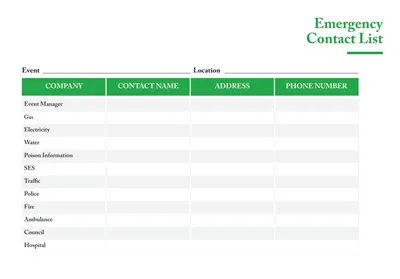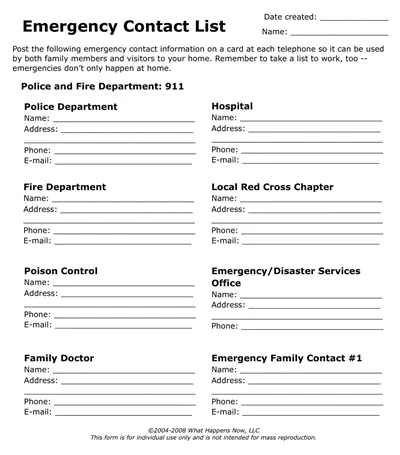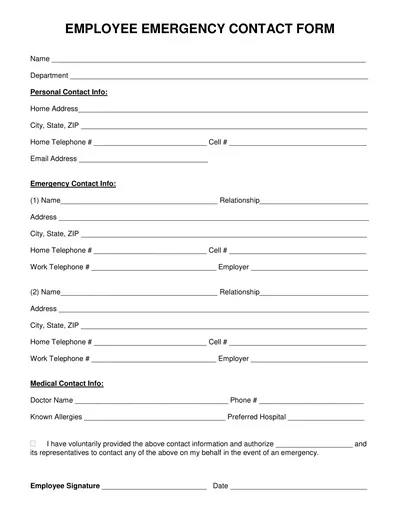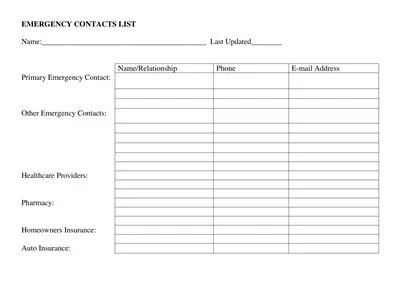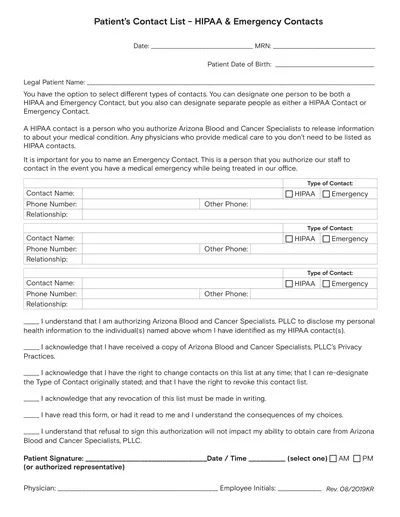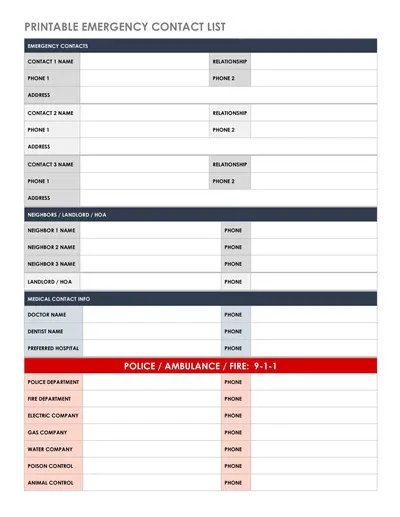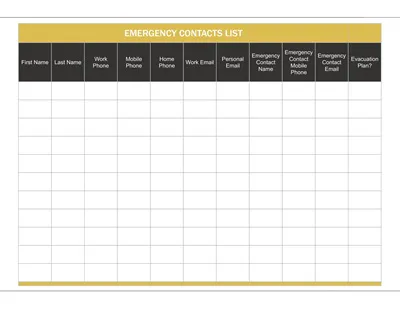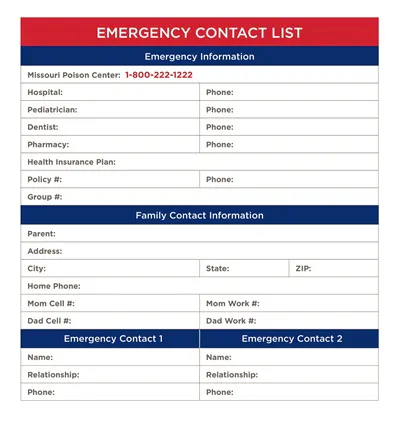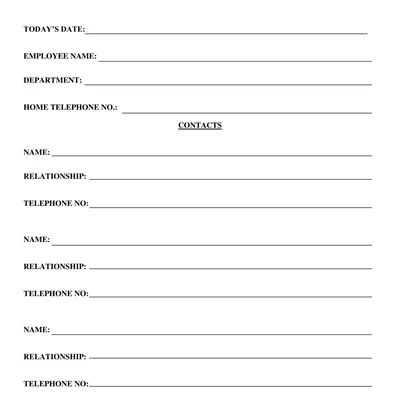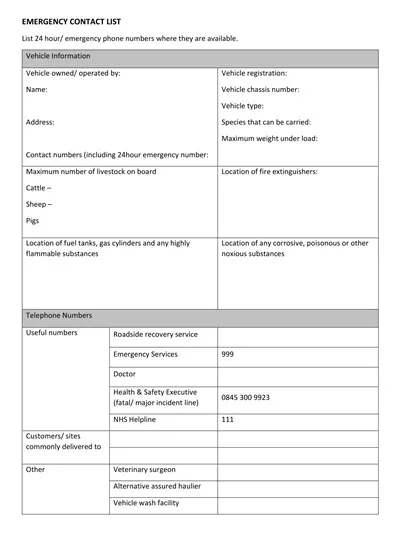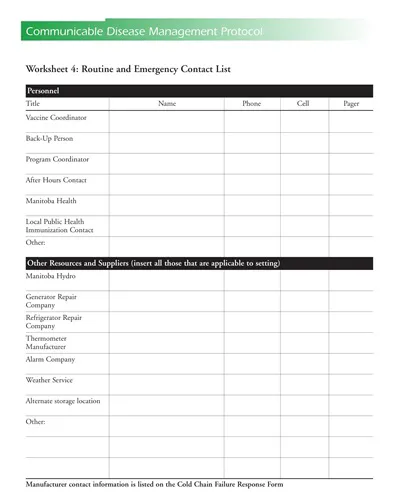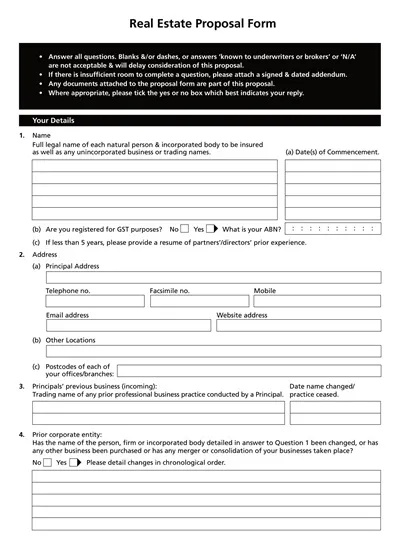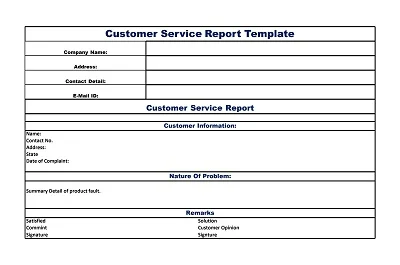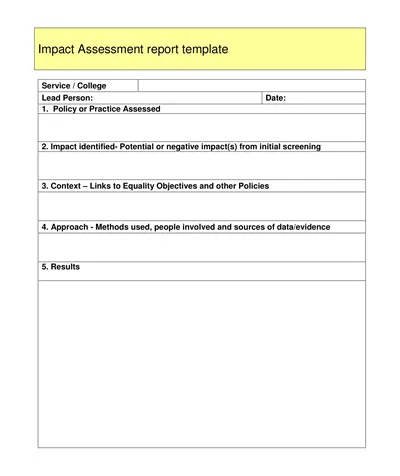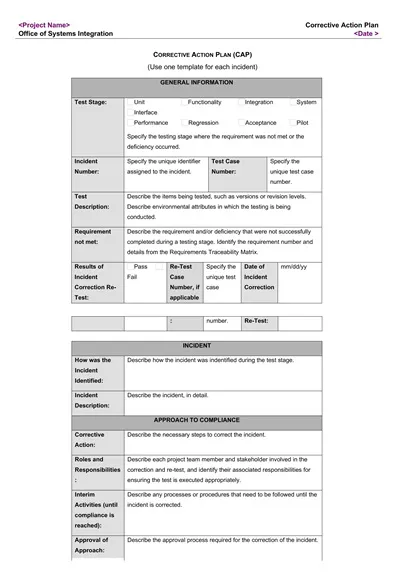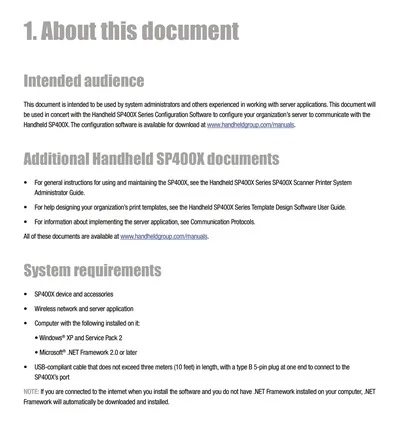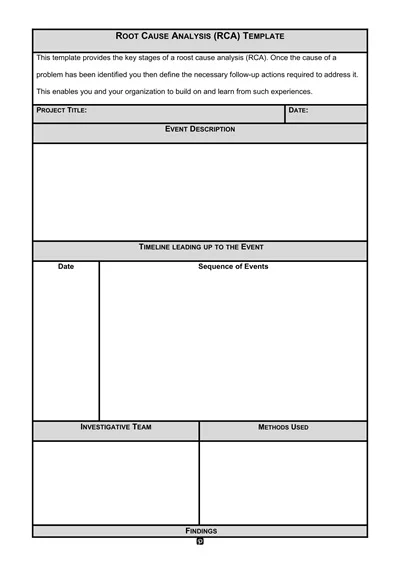An Emergency Contact List Template is a ready-made document that includes fields to list and organize important contact details of individuals or organizations to be contacted during an emergency.
In this way, it supplies a structured format in which one can easily access vital info like names, phone numbers, and relationships at a fast rate, which helps bridge effective response and communication when in urgent situations.
Download Free Printable Emergency Contact List Templates
What is an Emergency Contact List?
An Emergency Contact List is a list that can be written or digital, that lists the names and contact information of people, groups or public agencies to notify if an emergency arises. Does this list not work to make sure that the right people know as soon as possible when bad things happen and no one expects them, be it medical emergencies, accidents, natural disasters, or other urgent situations?
The main goal of an emergency contact list is that it allows you to quickly reach out to vital contacts that can either help you, make decisions, or give you the required information in the shortest suitable time. For personal safety, workplace preparednes, and community emergency planning, it is a vital tool.
Types of Emergency Contact List
You can tailor your Emergency Contact List to your surroundings or what you are doing. Details on the major types follow, as each focuses on specific groups during emergencies.
Personal Emergency Contact List
You can use this list by yourself or with your family. It involves people you can count on when you need help in an emergency.
- It often looks like this:
- Parents, spouse, and siblings are all part of your family.
- Those who live close to you
- Family physician
- Fire, ambulance, and police teams from your community
- Either an insurance company or emergency roadside help
Workplace Emergency Contact List
Used by employers to quickly communicate with staff during a safety issue.
- Commonly, you will find these points being discussed:
- An employee’s emergency point of contact (spouse, parent, etc.)
- HR professional or a safety officer
- Security personnel
- The local hospital or emergency representatives
- Looking after or overseeing a facility
School Emergency Contact List
Kept up by schools to help students and staff when emergencies happen.
- Student’s caregivers
- Emergency transportation contacts
- The school nurse or a licensed medical worker
- The police department and the fire service
- Both school administrators and teachers
Medical Emergency Contact List
Meant for individuals with health issues that do not go away. It allows professionals and caregivers to be informed about care quickly.
- General physician
- Medi-legal specialists are often involved, such as experts in heart disease, allergic and immunological conditions.
- A family member to contact during an emergency
- This provider covers your health costs.
- Which hospital or clinic do you most want to go to?
Travel Emergency Contact List
Helpful regardless of whether you’re leaving or staying within your own country. It includes important information needed if something unexpected happens while you’re abroad.
- Contact us from home if an emergency happens
- A company that sells travel insurance
- A place where diplomatic services are offered is known as an embassy or consulate.
- Tour guide
- Emergency contact numbers, like the police and ambulance.
Childcare or Babysitter Emergency Contact List
It is ready for those looking after children to use when an emergency occurs.
- People who have parental authority
- A relative or neighbor from nearby
- Pediatrician
- There are medical specialists at the poison control center.
- Emergency services should always have your home address.
All kinds of emergency lists are needed for special purposes and should be updated often to ensure they remain accurate and useful.
Key Components of an Emergency Contact List
To prepare you to handle emergencies more efficiently, it is necessary that you have some important components in your emergency contact list.
- Full Name: Complete names of each contact person or organization.
- Relationship to the Person: This is the person’s relationship to you (for example, a parent, a spouse, a doctor, or a manager).
- Phone Numbers: If you have more than one, such as home, work, mobile, et, provide them – it’ll be easier for the recruiting agency personnel to contact you.
- Email Address: Contact via Alternate Email Address (if communication is maintained over the phone, it is not possible).
- Physical Address: To find someone, know where they live, or when you need first responders to come.
- Medical Information (if relevant): Important health information, including allergies, medications, and chronic illnesses.
- Emergency Services Numbers: Police, Fire Department, Ambulance Reference, Poison Control, etc., ask local emergency services for numbers.
- Insurance Information: We take the following insurance information: Health insurance, vehicle insurance, or travel insurance, to speed up the claim or treatment.
- Preferred Hospital or Doctor: Ensuring fast access to familiar or trusted supplies of complete, suitable, beneficial, and connected healthcare providers.
- Special Instructions or notes: Anything else important to know besides name, phone number, and the address (language spoken, access codes, etc.), as well as any caregiving needs.
Including these makes the contact list useful in every situation to may be encountered.
Why You Need an Emergency Contact List
An Emergency Contact List is an important tool for various purposes. When there is an emergency—medical, accident, natural disaster, or urgent situation in any case, having a group of clear and accessible contacts, a list of vital contacts, can speed the response and communication.
It assists first responders, medical personnel, coworkers, or even strangers to let your loved ones know or get the services you need quickly. It can be especially important if you can’t speak or act for yourself. It is also that extra bit of peace of mind that families, schools, and workplaces can rely on knowing who to contact and how. Ultimately, an emergency contact list is an essential part of better decision making, timely assistance, and even life-saving.
Benefits of using the Emergency Contact List
An emergency contact list is a list of people you can call on in case of emergency, whom you have given prior knowledge of how to contact you, where you are going, and what to anticipate since you are going to be coming in contact with strangers.
1. Faster Communication
Every second matters in an emergency. An emergency contact list speeds up the process of reaching the right people without wasting time figuring out who to call or email.
2. Increased Safety and Security
Having accurate, up-to-date contact, eliminates the confusion, and the help comes in quickly, preventing scenes from worsening.
3. Peace of Mind
That’s reassuring for you, but also for your loved ones or key contacts, knowing that even if you can’t get to them yourself, they will know immediately all is not well.
4. Better Coordination During Emergencies
Emergency contact lists help medical personnel, as well as family members, employers, and all other parties involved in assisting in the situation, coordinate efforts.
5. Essential for Medical Emergencies
If, for some reason, you can’t talk because of injury or illness, the list can help healthcare providers tell your family members and get essential health information right away.
6. Useful in Various Settings
Having a structured emergency contact list, regardless of home, school, work, or when travelling, in the event of an emergency does ensures preparedness in different environments and situations.
How to create an Emergency Contact List Template
It’s a simple technique that requires collating all the essential contact details into a clear, easy format, in case of emergencies.
- Establish categories of contacts to include (such as friends, family, work-related contacts, medical practitioners, and emergency services etc)
- Then decide on what type of format it should be (digital, printable form, spreadsheet, or a form of an app).
- Build fields for important things such as name, relationship, phone numbers, email, and address.
- Also add space to write down medical conditions or special notes, such as ‘instructions about foot washing’ in old age.’
- Group similar contacts in a logical way.
- Anyone consuming the template must be able to easily update and distribute it.
- Fill the template out to check the clarity and completeness of the test.

